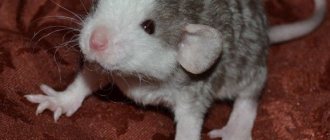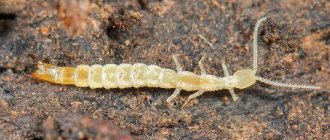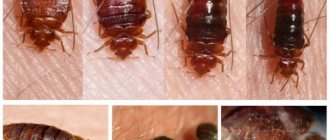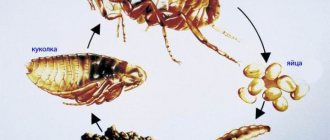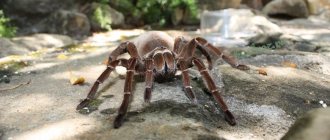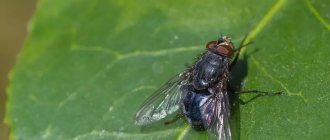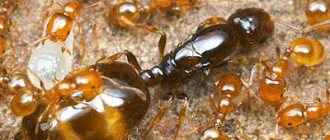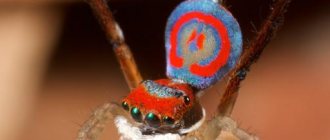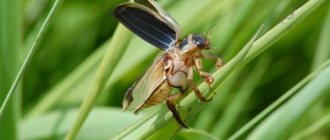Amazing insects that we very often encounter are wasps, bees, bumblebees, and hornets. How to distinguish them correctly, distinguish them in appearance. We study the life of insects and their behavior. How do their families differ, how do they build their nests and where do they winter. Do they attack each other and who is stronger. What danger do they pose to humans?
Nature gives us a lot of beautiful and amazing things, and insects are an integral part of it. There are a huge number of them and they are all unique in their own way. Some of the insects that people often encounter are wasps, bees, bumblebees and hornets.
We are wary of them because we know well that they can sting very painfully. Next, we will get to know them better, learn about their distinctive characteristics, lifestyle, behavioral characteristics, and also find out whether they actually pose a danger to humans.
What they look like
To be able to easily recognize an insect, you need to know what they look like, each of them has its own distinctive appearance characteristics, let’s get acquainted with them:
- Bee. They are distinguished by the most modest color. There is no sharp transition between the chest and abdomen, the body is shaggy. They have fairly thick legs, which are covered with hairs, and have small jaws.
- Wasp. We all know about the term “wasp waist” and this really only applies to this type of insect; there is a sharp transition between the abdomen and thorax. The body is more elongated and smooth. It has a fairly bright color of the body, there are bright yellow splashes on the black back, and the abdomen is painted with contrasting bright yellow and black stripes. The paws are yellow. The oral apparatus is equipped with fairly powerful mandibles.
- Bumblebee. It has a more impressive body size; its distinctive characteristic is the fluffy cover throughout the body. He also has a beautiful, bright color, has yellowish-red stripes, maybe with a red tint. Bumblebees are found in nature completely black.
- Hornet. They are the largest representatives, their body size can reach 5 cm. They are also distinguished by fairly large and powerful jaws. Outwardly, it resembles a wasp, but the striking difference between the hornet is the absence of a thin waist.
Types of hornets
There are different varieties of hornets, which differ from each other in external features and habitat. There are 23 species of these insects in total. Some individuals produce strong poison and are especially dangerous to humans. The only people that eat hornets are large spiders or birds. Let's look at the most interesting species in more detail.
Ordinary
The second name of this species is European. In appearance, it most closely resembles a giant wasp.
List of main characteristics of this type:
- The insects are large, the body length of an adult is 2.4–2.8 cm. The uterus can be up to 3.5 cm long.
- The abdomen of adult individuals has a two-color color consisting of alternately located black and orange-yellow transverse stripes. In females it is divided into 6 segments, and in males - into 7.
- Males and females of this species have different numbers of segments on their antennae. In females, each antenna consists of 12 parts, and in males - of 13.
- Only females have a sting and are used by females to protect the nest from attack. The tip size is about 3 mm.
- The front part of the insects' head is yellow, and the back part is red or orange.
- The habitat of the species is Europe, North America, and Asia.
Deplorable
In terms of external characteristics, it resembles a very large fly, but is one of the most dangerous types of hornets.
Let's consider the main characteristics of this type:
- Adults are solid black or dark brown. White stripes are visible on the abdomen.
- The insect's head is deep orange with a yellowish tint and is large in size.
- The mournful hornet secretes a particularly dangerous poison, which is highly toxic. Therefore, its bite can be fatal to humans.
- The homeland of representatives of this species is the Philippine Islands.
Oriental
This species is able to absorb sunlight and transform it into electricity. This property is explained by the presence in the body of insects of a special pigment - xenotropin.
Description of the eastern hornet:
- The body length of an adult is 2.4–2.5 cm, and that of the uterus is up to 3 cm.
- The wings have an oblong shape and a rich purple color.
- The body of insects is colored red-brown. There is a wide bright yellow transverse stripe on the abdomen.
- This species can build nests above the ground, as well as under tree roots and in dead wood.
- The habitat is eastern countries (Iran, India, Turkey, China, Pakistan) and southern European countries (Italy, Greece, Bulgaria).
Dybovsky's Hornet
He is also a black hornet, already mentioned in our article, in connection with his predatory parasitic habits - this species rarely stands its own nests, preferring to seize others. They live in China, Thailand, Japan, India, Transbaikalia.
Giant Asian hornet
Or Vespa mandarinia has also already been mentioned in our article as the largest hornet in the world - the length of some representatives of this species exceeds 5 cm. It is also the proud owner of the longest sting (about 6 mm), which makes its bite very painful and dangerous. Lives in Asian countries: Korea, China, Nepal, India, mainly in mountainous areas.
Japanese hornet
It is actually a subspecies of the Asian giant hornet native to Japan, where it is also called the “sparrow bee.” It is also a very large representative, its body length often exceeds 4 cm. It is also very dangerous; due to the presence of nerve toxins in the venom, its bite can be fatal; in Japan, about 40 people die every year due to the bite of this insect.
Lifestyle and nutrition
When it comes to bees, their diet consists solely of pollen and nectar. They feed with the help of a long proboscis, which is equipped with a mouthparts. Bumblebees and hornets also do not refuse nectar.
Hornets have a real sweet tooth and love berries and fruits, but their diet also includes small insects, which they can easily destroy with the help of their powerful jaws. It is worth saying that they are quite fearless, since there are cases when they even attacked small animals.
Wasps are also aggressors and true predators, but they are not as brave as hornets, since they never choose large victims. They often attack bees, but in this case it is not so easy to win.
The bees are already accustomed to the attacks of their opponents and have developed their own defense schemes, thanks to which they win. Wasps also have a sweet tooth; they love ripe fruits and berries, and their favorite delicacies are honey, jam, and syrup.
All these insects lead a gregarious lifestyle and live in large colonies. But bumblebees go in search of food alone, and it is also worth mentioning that they do this early in the morning, when other nectar lovers are still sleeping.
It's hard to believe, but they can spend 18 hours a day collecting food. Bees go in search of food in small groups, but wasps can gather in groups of up to 30 individuals.
Hornets also go for food alone, and they can easily cover a distance of 10 kilometers. If during such a walk they discover a beehive, they mark the place with a special secretary, which they allocate so that they can return here soon, but with their relatives.
When attacking a hive, they mercilessly kill the bees, biting off their heads and paws. The main prey is honey, which wasps also love. For this reason, insects cannot coexist side by side.
Social structure and reproduction
Photo: Hornet
Hornet wasps are quite prolific insects. However, not all females are fertile. Uteruses are capable of reproducing offspring. They are usually large in size. It is the females who become the founders of the hornet family; they begin the construction of the house (nest). Before laying eggs, the queen, with the onset of the first heat, searches for a safe, convenient place to build a house. She lays eggs after building the first few hundred.
Further, her responsibilities include searching for food and caring for future offspring. It takes some time for the eggs to mature. First, larvae emerge from them, then adults. When new members of the community become like adult hornets, they take over all the responsibilities of their parent. The queen continues to lay eggs, and the worker wasps get food, guard the house, complete its construction, and care for the larvae.
After four weeks, new hornets emerge from the larvae. They usually kill the queen due to her inability to reproduce any more. Some individuals simply kick her out of the nest. Representatives of the genus living in the European part do not live long. Their total lifespan is only a few months. Only queens have a long life expectancy. They are able to spend the winter in suspended animation.
Hornets can give a good rebuff to their enemy as a whole flock. To protect themselves, they know how to quickly mobilize forces. In case of danger, this animal releases an alarm pheromone. If such a signal is noticed by his relatives, then the attacker faces real danger.
Habitat
Domestic bees live in hives that humans build for them. Wasps are wild representatives, so they build their homes in trees, often in hollows. Bumblebees love more secluded places, one might say hidden from others, so they can choose an area in the ground to build a nest; less often, their houses are found in tree trunks and birdhouses. All representatives are found in different areas, this could be a forest, a summer cottage, a city park, or botanical gardens.
Hornets choose a variety of places to build nests; these can be the eaves of buildings, tree branches, hollows, or cracks in rocks. But wasps can make their home absolutely anywhere, on the branches of a bush, in the attic, in the stem of a plant, etc. The building material is tree bark, which they moisten with saliva, and it becomes soft; the nests they build look like thick paper.
Distinctive features of the nest
There are several signs of how to distinguish a hornet's nest from a wasp. Both insects build nests using a special secretion. The wood is chewed and a honeycomb is formed with the sticky mass. After time, the mass hardens and becomes paper-like.
The nests have the shape of an oval, pear, or ball. Consist of many tiers. The larger the nest, the larger the family. Wasps and hornets build their homes in old hollows, bird nests, under tree branches, in outbuildings, under the roof, in the attic.
On a note!
You can distinguish a wasp nest from a hornet house by color. In wasps it is gray, in hornets it is brownish. For construction, the latter insects use rotted wood and birch bark, so the color of the building material takes on a brown tint.
Insect nests
Differences between insects
These representatives are quite similar to each other, but at the same time they have many differences. They all have the ability to fly, they buzz, and each of them can sting painfully, in addition to which they secrete toxic poison. But they never attack just like that, only when they feel a threat to themselves or their family, this is how they defend themselves.
If you look at bees, it is worth noting their hard work; they are busy working all day long. In addition to collecting honey all day, they also build honeycombs, clean the hive, feed the young generation, provide ventilation to the hive, process and store the collected product.
The life cycle of a working individual is on average 1 month, but the younger generation grows up quickly and families are regularly replenished, so such a short life remains unnoticed by others.
Differences between a bumblebee and a bee
These are close relatives who have a fairly wide habitat. In fact, they have a huge number of differences. In total, there are about 300 species of bumblebees that live throughout the continents. The hind legs of females have a very beautiful shiny coating.
From edge to fold, the paws are covered with villi, which serve as a basket for collecting pollen. They have a round abdomen, without folded edges. The sting has a tubular internal structure, through which the poison penetrates under the skin when a bite is applied. The sting is smooth without serrations, so it can sting repeatedly without causing any harm to itself.
In turn, there are about 20 thousand species of bees, some of which have not been studied by science to this day. We all know that they are major pollen collectors and honey producers, as well as plant pollinators. They have 3 pairs of legs; on the inside there are villi, which also serve as baskets for collecting pollen. Abdomen bent downward.
Unlike the previous representative, they have an empty sting covered with jagged edges. When a bite is applied, these barbs cling to the edges of the wound, from which the sting comes off along with part of the abdomen, and the bee soon dies.
Let's look at the visual differences:
- Bumblebees have a round body and are much larger in size; bees have an elongated body.
- Bumblebees have brighter colors.
- Bees are used in open areas to collect pollen and pollinate plants, while bumblebees are used in greenhouses.
- A bee can only sting once, but bumblebees can sting multiple times.
Benefit or harm
Human economic activities benefit greatly from wasps, because insects pollinate plants. In addition, they take part in the food chain, influencing the prosperity of various species of animals and plants. These predators eat many agricultural pests, which include caterpillars.
Despite the fact that the glitter sting contains a very small amount of a poisonous substance that does not cause any harm to humans, for some people such a bite can be quite dangerous, causing a severe allergic reaction and the formation of swelling.
In case of a bite, it is necessary to give one injection of diphenhydramine so that the wasp venom is absorbed in a short period of time. In addition, the victim needs rest, constant warming of all extremities, as well as plenty of hot drinks. In this situation, you should definitely consult a doctor.
Differences between a hornet and a wasp
The largest representative of the wasp family is the hornet. The length of its body can reach 5 centimeters. In addition to the size of the body, differences also apply to the structure of the body. Hornets have a large head, a fairly wide and large chest, which is darker in color, and the abdomen is also larger.
There are differences in the construction of nests, namely in the building material:
- Wasps. They use tree fibers to build their houses. They moisten them in their saliva and chew them, obtaining a pliable building material. From the outside, such a house resembles crumpled paper; such a house has numerous layers, with honeycombs placed in the lower part.
- Hornets. They use rotted stumps and wood as building materials. Their nests are dark brown in color.
Regarding the territories where they live, they can be found in all regions of the country except the northern ones. In some regions, hornets are considered an endangered species. Regarding wasps, they are considered useless stinging insects, which is completely unfair.
Hornets inflict very painful stings, during which they release paralytic poison, which is highly concentrated. If a person suffers from allergic reactions, a bite can cause anaphylactic shock and even be fatal.
Wasps are distant relatives of wasps and ants. They differ in that they do not care for their offspring at all, they lay eggs in cells, after which they seal them and never return to them.
They have a sting about 5 mm long. They attack people only for protection when they feel danger. They attack with powerful jaws and then use a sting. At one time they can bite and sting several times. They feed on nectar, pollen, fruit and tree sap, and their diet also includes caterpillars and spiders.
Types of hornets
There are several dozen popular species. Hornets are part of the wasp family. They have a lot in common, but have a number of distinctive features that set them apart from other individuals. There are 23 species of hornets. The most common types:
- Common (living in Europe): brown, body length 35mm. It is distinguished by two bright stripes on the lower part of the body. It is well known to Russian gardeners and beekeepers, but was recently brought to the USA and now lives there.
- Black hornet (Dybowski): stripes on the black back are yellow (predator color). The wings are brown. Length 35mm. Few people are familiar with this type of hornet. Listed in the Red Book. They live in the Amur region, Transbaikalia and Primorsky Krai.
- Giant Asian: its body length is 6 cm, has a large wingspan. It is distinguished by its bright head and striped back. lives mostly in Asian spaces. It is also found in the mountains of Sri Lanka, as well as in India and Taiwan. It has a large sting about 6mm. The bite is dangerous and contains a toxic substance. One of the largest in the world.
- Japanese hornet (Japanese): a subspecies of the giant hornet called the "sparrow-bee" lives on Sakhalin. Large yellow head, large eyes, adjacent to them are 3 ocelli. The bite is painful and has dangerous consequences, as the venom contains toxins.
- Eastern: has the most elaborate coloring of all types. It is distinguished by a wide yellow stripe on its belly. Bright red with a crimson tint to the wings and body. One of the many species that tolerates heat well. Well adapted for living in deserts and steppes. Originally from North Africa.
- Philippine hornet: has a black color. Another name for the species is Lamentable. It is dangerous because it produces highly toxic poison. The bite is very unpleasant. The main habitat is the Philippine Islands.
Differences between bees and bumblebees and wasps
Bumblebees have a round body covered with fluffy fibers; they are darker than wasps and larger. Wasps, in turn, can boast of a bright, provocative color. The diet of bumblebees and bees consists of nectar and pollen; they use their proboscis to feed.
The wasp is omnivorous; in addition to pollen and nectar, they feed on the juice of fruits and trees; their diet also includes small insects. They often attack bee hives, using strong and sharp jaws.
Who is stronger: a bumblebee or a wasp
Their differences lie in the nature of their behavior: if the wasp is quite aggressive and easily attacks an enemy who is much larger than it in size, then the bumblebee is a very peaceful insect, and only in extreme cases uses its weapon.
Quite often, wasps attack the nests of peace-loving bumblebees in order to steal their food supplies; they attack with the help of their jaws and stings. When the bumblebee family is healthy, they easily cope with the attackers, but if it is weak, the wasps win, and can kill not only the working individuals, but also the entire young generation.
Don't want to endure an insect infestation?
Call us right now!
+7 (495) 363-87-20
+7 (903) 002-82-30
+7 (977) 282-30-30
+7 (925) 407-37-57
Pest control in Moscow from the professionals of our company!
Note that the word pest control comes from a combination of two Latin words “des”, which means against and “insectum”, which means insect. Accordingly, disinfestation is the fight against insects. Disinfestation of cockroaches in Moscow allows you to get rid of these harmful and unpleasant insects in one procedure.
There are two types of disinsection - preventive and exterminatory. Preventative allows you to create conditions in the room under which insects will never appear in it. Extermination is necessary when insects have nevertheless entered your home and need to be urgently destroyed.
The best disinfestation in Moscow from our company’s specialists is carried out using the most effective methods, using innovative technologies and modern insecticidal preparations. In our work, we take into account all the requirements for this type of activity from the sanitary and epidemiological legislation in force in our country.
If you notice redness, consult a doctor immediately! And trust the Biotriks service to clean your home!
We carry out a set of measures aimed at the complete destruction of any insects, be it cockroaches, bedbugs, fleas, ticks, etc. We carry out disinsection by applying a special composition to indoor surfaces.
The composition depends on the type of insect being exterminated. A feature of such drugs is the preservation of a long-lasting effect over time. If you want to get rid of insects forever, then we can offer a radical method, namely the use of a cold or hot fog generator. Nitrogen droplets are mixed with an effective insecticidal preparation in a special device (generator), after which treatment is carried out.
You can sleep peacefully, we will carry out the treatment with a guarantee of long-lasting results!
The peculiarity of this method is that the drug reaches even the most inaccessible places, which absolutely guarantees the complete extermination of insects in one go. Usually cold fog is used, but if the premises are industrial or the case of insect infestation is really very serious, then the hot fog method is used.
It should be noted that all the means and technologies we use, although destructive to insects, are completely safe for the life and health of people and animals, but you should still prepare for the procedure before the procedure. Preparation consists of wet cleaning, covering furniture with film, and protecting food.
Do you want your home to be overrun with parasites?
Don't go to extremes!
☎ Call us right now and order pest control with a competitive price guarantee!
+7 (495) 363-87-20
+7 (903) 002-82-30
+7 (977) 282-30-30
+7 (925) 407-37-57
After disinfestation, the room should be ventilated for some time. Depending on the type of insects and the means used to kill them, ventilation can take from an hour to five hours.
What types of insects are there?
As a rule, most often in residential and non-residential premises we have to destroy cockroaches, bedbugs, ants, ticks, linen lice, and moths.
In country houses, we offer services for cleaning ponds from mosquitoes. Remember that all the insects mentioned above are carriers of deadly diseases. Some insects carry diseases on their legs, but the most dangerous are blood-sucking insects, such as bedbugs, lice, and mosquitoes, since they can introduce the source of infection into the human blood.
Pest control, and more!
In addition to pest control services, we offer deratization services (rodent extermination). It should be noted that during any procedure you don’t even have to leave the room. It's all about the safety of using products for human life and health.
Remember!!! It is better not to get rid of insects on your own.
- Firstly , it is ineffective.
- Secondly , it can be far from safe. The thing is that in our work we use only modern, innovative and certified drugs, which we purchase from well-known suppliers. As for store-bought products, they can be very toxic, and their effectiveness has not been proven. Not only will you not get rid of insects, but you may also get poisoned.
Where do hornets and wasps spend the winter?
With the arrival of cold weather, wasps go for the winter; for this they need to find a secluded place. Most often they overwinter under the bark of a tree, in the cracks of outbuildings, hollows, and old stumps. Until this time, they must accumulate a large amount of nutrients, which will be gradually consumed throughout the winter. They leave the nest they build over the summer and never return to it.
In hornets, this process is almost identical, but there are differences. Over the summer, they build a nest and make nutritious food reserves, raising the young generation. With the arrival of autumn, the females leave the nest to mate and then find a secluded place for the winter. At that time, the workers begin to close all exits from the nest; throughout the winter they will remain inside and feed on the reserves they have made.
If severe frosts strike, unfortunately, the working individuals will die, but the queen will remain, and with the arrival of warmth, she will lay eggs and create a new swarm. Wintering involves deep and long sleep, which continues until early spring.
Females that left the colony in the fall, after hibernation, look for a new place to build a nest and create a separate colony. These amazing insects are listed in the Red Book as they are considered an endangered species.
What to do if bitten by a hornet
If you have been bitten by a hornet, you must immediately take the following measures:
- Take an antihistamine, for example, Suprastin, as quickly as possible; it will slow down the occurrence of an allergic reaction.
- You can try to suck out the poison released by the hornet from the wound, but you need to do this very quickly, since the skin at the site of the bite begins to tighten and if you missed 1-2 minutes after the bite, then there is no point in doing this.
- It is worth putting a cold compress on the bite site; it will slow down the spread of the poison and at the same time reduce swelling of the skin.
- Apply Fenistil gel to the bite area.
- If you have a fever after being bitten, do not bring it down unless it rises above 38 C.
- Do not drink alcohol under any circumstances.
- If you feel worse, do not hesitate to call an ambulance.
